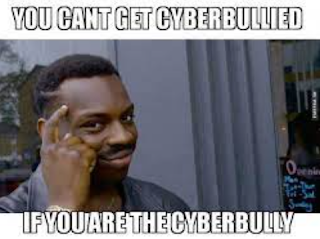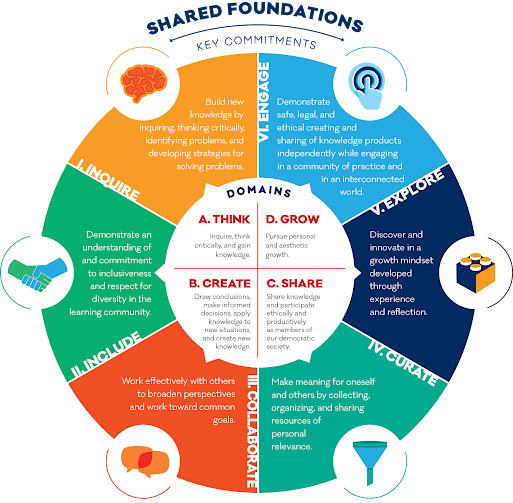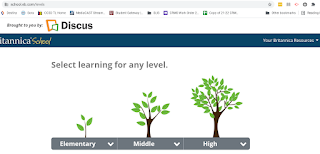Cyberbullying: Ew
 |
| makeameme.org |
What is there left to say? I've really spent some uncomfortable hours sitting with the topic this week, and rather than feeling better equipped to prevent or effectively address the issue, I feel disheartened about its indissoluble nature and seeming inevitability. THANKS, DR. GREEN! 😉
I appreciate the framing from this week's Faucher et al. piece of cyberbullying as repeated behaviors intended to cause harm and born out of a desire for or assertion of power. Is one mean text or mean-spirited social media post cyberbullying, maybe not, but it could be indicative of a deeper and budding pattern of abuse, and we have little hope of eradicating the weed if we do not first locate and pull it out by its root. Studying those roots can tell us how the organism of cyberbullying grows and thrives, so that we are better equipped to combat its spread. But wow, is that a daunting challenge.
In terms of appeal and consequence, cyberbullying is like any other crime: it serves the bully's perceived need for power and use of coercive force at the expense of the victims and without any regard for that impact, provided the perpetrator is not caught or stopped. It's easier than doing the work of healing whatever void the attack aims to fill, and there are most often no consequences at all for taking a shortcut and causing harm. That harm is all to real for the victims of cyberbullies, though, as we saw in some of this week's videos and as many of us know from experience.
Conditions for cyberbullying could scarcely be any better than they are today, further exacerbating the outlook for the future. Tech innovations have laid the groundwork for relentless connectivity and communication between people from every background. Information spread is unfettered by the constraints of time, proximity, even language, and this is true whether the information is helpful, neutral, or harmful. One product of this pipeline that I think gets overlooked is how, while it is a relatively recent development in human history, there are now people with the same access to it who have not lived a day without this ability to fire off a hateful or cruel remark to an audience of unknown size on a whim. The young people in our lives are more connected to their peers and even their icons than we were 20 or 10 or even 5 years ago. The majority of us know the twisted pleasure of shared judgement or hatred, and we all know that the pull of that bonding pleasure is strong in the school environment.
Tough to feel like we stand any chance against an enemy so uniquely prolific and pervasive. Where do we even begin? I do think that this week's readings and viewings helped me to broaden my definition and understanding of cyberbullying, and to reflect on the ways it rears its ugly head in my own radius. That is not nothing, and illustrates the potential effectiveness of simply asking people to consider the topic, so long as they have concomitant access to resources on identifying, understanding, and eradicating cyberbullying. And the ways that I think we most meaningfully transform that combination of exposure and information resources into changed and sustained behavior are to walk what we talk. As educators, we must proactively model epathy, kindness, restraint, advocacy for others and better digital citizenship in our spaces, our interactions with others, and ourselves. It is not enough to honor Digital Citizenship Week once a year, or to present the same tired antibullying guidance lessons again and again. As the issue evolves, so too must our treatment of and teaching on it. Updating digital citizenship curriculum is a good first step. We also stand to learn about best practices through data analysis and studying the communities where cyberbullying is less common or more staunchly regulated.
 |
| Graphic courtesy of https://www.websitebuilderexpert.com/ |
In states that boast lower cyberbullying rates, like New Hampshire, there is legislation that promotes online accountability and protects would-be victims of the crime. We most assuredly have room for improvement here in South Carolina, for example, where cyberbullying laws do not even extend beyond the walls of our childrens' schools (Assistant Secretary for Public Affairs, 2021). If we wish to be effective as advocates for our kids and for safe school and digital environments, we must take institutional and individual measures to teach and enforce tolerance, kindness, and empathy.
Assistant Secretary for Public Affairs (ASPA). “South Carolina Anti-Bullying Laws & Policies.” StopBullying.gov, 2 Nov. 2021, www.stopbullying.gov/resources/laws/south-carolina.
Carmichael, Charlie. “Which US State Is the Biggest Cyberbully?: New Research.” Website Builder Expert, 18 Apr. 2019, www.websitebuilderexpert.com/blog/us-state-biggest-cyberbully/
Center, C. R. (2021, October 13). Cyberbullying videos to use in presentations. Cyberbullying
Research Center. Retrieved March 12, 2022, from https://cyberbullying.org/videos
Faucher, C., Cassidy, W., & Jackson, M. (2015). From the sandbox to the inbox: Comparing the acts, impacts, and solutions of bullying in k-12, higher education, and the workplace. Journal of Education and Training Studies, 3(6). https://doi.org/10.11114/jets.v3i6.1033
Orech, J. (2012). How it's done: Incorporating digital citizenship into your everyday curriculum. Tech & Learning, 33(1),
16-18.



The meme! That grabbed my attention.
ReplyDeleteThe chart you included is so interesting. I have never thought about which states were the "meanest" versus "friendliest" in regards to Cyberbullying. Although South Carolina is not in the top 10, it seems that it is 11th-20th! I think you are right that one of the ways to to prevent cyberbullying is for educators to model it. We are taught to model our lessons and I think one of the ways to show students how to act online is to model it. I know I have told students that I do not add everyone that requests to be my friend on Facebook. It always shocks them since they add everyone! You can have 5000 friends on Facebook and they try to get all 5000 of those slots filled up. Who actually knows 5000 people well enough to give them such access to them! All teens want to be celebrities in their own life. ~Jessica Quesinberry